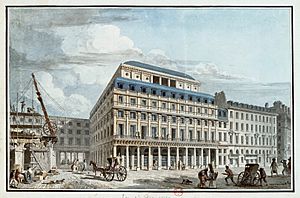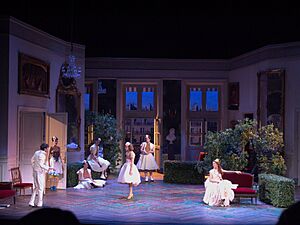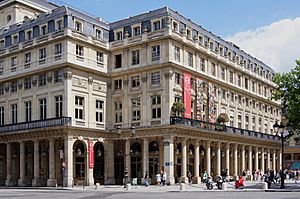Comédie-Française facts for kids
|
|

Principal theatre of the Comédie-Française, the Salle Richelieu, seen from the intersection of the Rue de Richelieu with the Avenue de l'Opéra
|
|
| Founded | 1680 |
|---|---|
| Founder | Louis XIV |
| Purpose | Theatre company |
| Headquarters | 2 Rue de Richelieu, 1st arrondissement of Paris, France |
| Website | www.comedie-francaise.fr |
The Comédie-Française, also known as the Théâtre-Français, is a famous national theatre in France. It was started in 1680, making it the oldest theatre company in the world that is still performing today. This special theatre is controlled by the French government. It is one of the few in France that has its own group of actors who work there all the time.
The main place where the Comédie-Française performs is called the Salle Richelieu. This theatre is part of the Palais-Royal complex in Paris. People also often call the theatre "La Maison de Molière," which means "The House of Molière." This name comes from the famous French playwright, Molière. He is seen as the special protector of French actors. Even though Molière passed away seven years before the company officially became the Comédie-Française, his name stuck with them.
Contents
The History of Comédie-Française
How the Theatre Company Began
The Comédie-Française was officially created on August 8, 1680. This happened because Louis XIV, the King of France, ordered two theatre groups in Paris to join together. These groups were from the Guénégaud Theatre and the Hôtel de Bourgogne. Before this, in 1673, Molière's own theatre group had already joined with another one called the Théâtre du Marais.
A few years later, the king gave them money to help them perform. Seven years after that, they were given their official name, the Comédie-Française.
The newly combined theatre company performed for the first time on August 25, 1680. This show took place at the Guénégaud Theatre. Many important actors were part of this first performance. These included Molière's wife, Armande Béjart, and other famous actors like La Grange and Baron. The plays they performed were mostly by Molière and Jean Racine. They also performed some works by other writers like Pierre Corneille.
The Theatre Through the Years
In the 1700s, many rich French nobles enjoyed going to the Comédie-Française. It was seen as a special and expensive treat.
Later, in 1789, during the time of the French Revolution, there were big arguments among the actors. This happened after a play called Charles IX was performed. The arguments were about politics and caused the company to split into two groups. One group supported the king and was called the "Théâtre de la Nation." The other group supported the new ideas of the revolution. This group was led by a young actor named Talma. They started their own theatre called the "Théâtre de la République." This new theatre was built where the current Comédie-Française stands today.
On September 3, 1793, during the French Revolution, the "Théâtre de la Nation" was closed. This was ordered by the government because they thought a play called Pamela was causing trouble. The actors were put in prison, but they were slowly released later. On May 31, 1799, the government allowed the actors to come back together. They were given the Salle Richelieu as their new home.
Today, the Comédie-Française has a huge collection of about 3,000 plays. It performs in three different theatres in Paris. These are the Salle Richelieu, the théâtre du Vieux-Colombier, and the Studio-Théâtre.
Performing During the COVID-19 Pandemic
Starting in October 2020, the Comédie-Française had to close its doors. This was because of the COVID-19 pandemic, which caused all theatres in France to close. Since the Comédie-Française has its own group of actors, they decided to start performing online.
They offered online readings of famous books, like In Search of Lost Time. They also started a special online program called Théâtre à la table. In this program, actors would rehearse a play for one week and then perform it online.
Many people watched these online shows, even more than they expected. Viewers came from outside Paris and from other countries too. In May 2021, the director of the Comédie-Française, Éric Ruf, said that 30% of the online audience had never been to the theatre before. He also said they would keep offering online shows even after the theatre reopened.
The Theatre Buildings
The Comédie-Française has had several homes since it started in 1680. Its first home was the Salle Guénégaud. In 1689, it moved to a theatre across from the Café Procope. From 1770 to 1782, the company performed in the theatre inside the royal palace of the Tuileries.
In 1782, the company moved to the Salle du Faubourg Saint-Germain. This building was designed by famous architects Marie-Joseph Peyre and Charles De Wailly. Since 1799, the Comédie-Française has been in the Salle Richelieu. This theatre was designed by Victor Louis. It was made bigger and changed in the 1800s. Then, it had to be rebuilt in 1900 after a big fire. Sadly, one actress, Jane Henriot, died in that fire.
The Theatrical Troupe
The actors who are part of the Comédie-Française are divided into two groups: sociétaires and pensionnaires. The sociétaires are the main, long-term members of the theatre company. After working for 20 years, they receive a pension, which is like a retirement payment. The pensionnaires are paid actors who are newer to the company. After working for a certain time, a pensionnaire can become a sociétaire. Many of France's greatest actors and playwrights have been part of the Comédie-Française at some point in their careers.
Honoring Molière
Every year on January 15, the Comédie-Française performs a special "Homage to Molière." This date is the anniversary of his christening, and possibly his birthday. After the evening's performance, which is usually free, all the actors gather on the stage. They stand behind a statue of Molière and wear costumes from different plays in the theatre's collection.
First, they walk in lines and bow to the audience, who clap for them. Then, each actor says a line from one of Molière's plays, and the audience claps again. To finish, the oldest member of the troupe introduces any new actors. They also honor any sociétaires who are leaving the company.
This tradition started in 1773, on the 100-year anniversary of Molière's death. In 1821, the date was changed to his christening date. The next year, it became more like it is today, as the final part of a play written especially for the occasion. In the 1800s, the play The Imaginary Invalid was often performed on this day. This was because its final scene allowed all the actors to appear on stage. Other theatres also started similar tributes, but the Comédie-Française is the only one that has kept this special tradition going.
Leaders of the Comédie-Française
The main leader of the Comédie-Française has been called the administrateur général since 1850. Before that, they had different titles.
See also
 In Spanish: Comédie-Française para niños
In Spanish: Comédie-Française para niños
- Troupe of the Comédie-Française in 1680
- Troupe of the Comédie-Française in 1752
- Troupe of the Comédie-Française in 1754
- Troupe of the Comédie-Française in 1755
- Troupe of the Comédie-Française in 1772
- Troupe of the Comédie-Française in 1790
- List of works by Henri Chapu. Bust of Alexandre Dumas Pere
- Battle of Hernani




